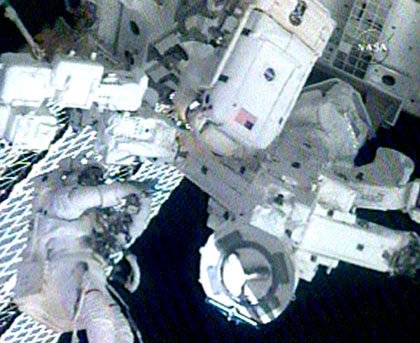Astronauts to Test Space Station's New Robotic Handyman

HOUSTON -Two astronauts will step outside the International Space Station (ISS) tonight tooutfit a giant maintenance robot with its tool kit and attach a new experimentto the orbiting laboratory?s hull.
ShuttleEndeavour astronauts Rick Linnehan and Robert Behnken are set to head out the station?sQuest airlock hatch at 7:23 p.m. EDT (2323 GMT) to add the orbital tool belt tothe Canadian-builtDextre robot, a two-armed automaton designed to replace human spacewalkersfor routine maintenance on the ISS exterior.
?It?s kindof surreal to be out there and floating around in space looking out at thisgiant, white robot that looks like something from ?Star Wars,? Linnehan said ina televised interview late Sunday. ?But it isn?t sci-fi, this is reality.?
Tonight?s planned6 1/2-hour spacewalk will mark the third of five planned spacewalks for theEndeavour crew?s 16-day mission to deliver Dextre, the firstmodule of Japan?s massive Kibo station laboratory and a new crewmember tothe ISS. Linnehan, Behnken and station flight engineer Garrett Reisman attachedDextre?s hand-like gripping tools and two, 11-foot (3.4-meter) arms during twoearlier spacewalks before they began moving the robot?s metal limbs duringbrake tests on Sunday.
?Itdefinitely looked as if something were coming alive, like Gigantor orFrankenstein, as the pieces of Dextre were coming together and we got it movingthis morning,? Behnken said late Sunday.
Armed withgripper hands equipped with built-in socket wrenches, lights and cameras, Dextre- short for Special Purpose Dexterous Manipulator - is the Canadian SpaceAgency?s third major contribution to the ISS after the Canadarm2 robotic armand its anchor-like Mobile Base System on the station?s railcar work platform.
The 3,440-pound(1,560-kilogram) robot can rotate its torso and is designed to operate from theMobile Base platform or the tip of the station?s Candarm2. To avoid banging itsarms together, the robot will move one arm at a time, using one limb to steadyitself against the ISS while the other draws on an array of three differenttools to remove bolts, retrieve broken components and replace them with spares.When complete, Dextre will stand 12 feet (3.7 meters) tall.
Get the Space.com Newsletter
Breaking space news, the latest updates on rocket launches, skywatching events and more!
Duringtoday?s spacewalk, Linnehan and Behnken will attach Dextre?s tool belt-likeholster to an outrigger platform on the robot?s waist. They will also attach a6-foot (almost 2-meter) long boom that will be used to stow spare parts for transportto work sites outside the ISS. The spacewalkers will cap their robot work byremoving several thermal covers from Dextre?s exterior and preparing the cargopallet that delivered it for the return to Earth in Endeavour?s payload bay.
Linnehanand Behnken will also attach a materials exposure experiment to a porch-likespot at the tip of the station?s European Columbus lab. The briefcase-sized experimentwill expose a variety of materials and coatings to the space environment todetermine their usefulness in the design of future spacecraft, NASA officialssaid. The spacewalkers will also deliver a spare robotic arm joint and twospare direct current switching units to support the station?s power grid.
Today?sspacewalk will mark the sixth excursion for Linnehan and the first for Behnken,though he worked with Reisman to move Dextre?s arms into an overnight stowposition late Sunday.
?It flewlike a dream,? Reisman told Mission Control of the more than $200-million Dextrerobot. ?Nice and smooth.?
NASA isbroadcasting Endeavour's STS-123 mission live on NASA TV. Click here for SPACE.com'sshuttle mission coverage and NASA TV feed.
- NEW VIDEO: Space Station's Dextre Robot, AKA 'Gigantor'
- NEW GALLERY: Launch Day for Shuttle Endeavour
- NEW VIDEO: Japan's First Space Station Module
Join our Space Forums to keep talking space on the latest missions, night sky and more! And if you have a news tip, correction or comment, let us know at: community@space.com.

Clara Moskowitz is a science and space writer who joined the Space.com team in 2008 and served as Assistant Managing Editor from 2011 to 2013. Clara has a bachelor's degree in astronomy and physics from Wesleyan University, and a graduate certificate in science writing from the University of California, Santa Cruz. She covers everything from astronomy to human spaceflight and once aced a NASTAR suborbital spaceflight training program for space missions. Clara is currently Associate Editor of Scientific American. To see her latest project is, follow Clara on Twitter.









